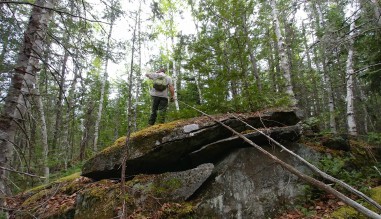
Sometimes plans can go completely awry and become completely vindicated at the same time. That very thing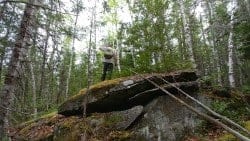 happened with Jarhead Survivor and I on our “planned” bug-out trip, completely validating the essence of our excursion. In case you missed it, my last post on Survival Cache gave an introduction to the mock bug-out that Jarhead Survivor and I executed in May, 2018 in the hopes of actually seeing how we would perform under the auspices of an actual SHTF event. In case you missed it, you can read the article via the link below – it’s definitely recommended you check this article out to set the stage for the rest of this post.
happened with Jarhead Survivor and I on our “planned” bug-out trip, completely validating the essence of our excursion. In case you missed it, my last post on Survival Cache gave an introduction to the mock bug-out that Jarhead Survivor and I executed in May, 2018 in the hopes of actually seeing how we would perform under the auspices of an actual SHTF event. In case you missed it, you can read the article via the link below – it’s definitely recommended you check this article out to set the stage for the rest of this post.
By Drew, a contributing author of Survival Cache & SHTFBlog
This is part II of a III part Series on Drew & Jarhead Survivor Conducting a practice Bug Out.
Read Part I (click here)
As a quick synopsis for those who didn’t/won’t read part one of “Walking the Walk”, fellow Survival Cache/SHTFblog writer Jarhead Survivor and I decided to take a long weekend and run a bug-out scenario. We generated a general hypothetical SHTF situation that would necessitate an immediate bug-out, and we generally let the scenario dictate our course of actions. Our decisions took us on a three-hour road trip to the wilds of northwestern Maine. This article will take us there, and tell the tale of the actual trip – what happened, why we did what we did, and what we screwed up. Part three of this series will go over what we learned from our bug-out – stay tuned. Just as a warning – it’s a bit of a read! This article comprises the trip narrative only, not the synopsis of what we learned. However, it provides perspective to backup the lessons outlined in the next articles.
Packing the Truck: What We Brought
I live about two or so hours from Jarhead Survivor, so I got out of work a little early on a Friday afternoon, and spun up the Maine coastline to the Jarhead Lair. The scenario that Jarhead Survivor and I ran with dictated that we were meeting up to take a canoeing trip down a nearby river, so I had my Old Town Discovery 158 canoe and canoeing accoutrements, a cooler with some beers and some food (standard Mainer canoeing fare) plus my normal EDC and the emergency gear that I always keep in my truck. This consisted of my Bug-Out/Get Home bag, a Ruger 10/22 Takedown with three loaded magazines and a couple spare boxes of ammo, and a small 2-man pup tent with Cabela’s inflatable ground pad and a light sleeping bag. The EDC gear on my person consisted of a .45 ACP Sig Sauer P220ST with some loaded mags and holster, a Benchmade D2 steel Mini-Griptilian folding clip knife, a Bic Lighter, a Streamlight MicroStream AAA LED flashlight, and a small Silva compass. I had a #10 can of Mountain House Chicken A La King and a 10-inch well-seasoned cast iron skillet in the truck with me as well. However, aside from some extra clothes and other sundry items that were just in the truck, this is what I had – and what I would be confined to using on our bug-out trip. In the spirit of the unpredictable bug out, once I left the driveway, there was no going back. Of course, had I “known” I’d be leaving my house (possibly forever) on a bug out, I would have packed differently.
Related: 11.5 Bug Out Mistakes That Are Not
Jarhead Survivor was in a better situation when our hypothetical balloon went up. Per our faux “nuclear attack” scenario, we were at his house when the catastrophe occurred, and we calculated we had a about an hour and a half to assess, pack, and leave before the fallout would be a problem. So we had the pick of his survival gear to accompany my minimalist set. Jarhead Survivor brought his tried-and-true bug-out pack plus another, larger pack with clothes, a tent, sleeping bag, and a few luxuries. His LifeStraw family-sized gravity filter came with us, as did a large hurricane lantern and some fuel, tarps, extra paracord, another cooler with food and ice, camp chairs, lightweight aluminum and plastic canoe paddles, a large solar charger for our devices, a few cooking accessories/spices, a camp coffee percolator, and a large waterproof plastic tote to carry gear in. All this was sourced, accrued, tentatively packed in the canoe, then loaded in Jarhead Survivor’s crew cab 4WD Dodge Ram (my Tacoma was a bit cramped) within our pre-determined time frame. Care was taken to keep sensitive gear or clothing in the cab of the truck, or in the tote. With a final check to make sure we had a map and navigation gear, we hit the road.
Heading Out to Bug Out
Jarhead Survivor and I navigated our way from Southeast Maine to northwestern Maine, taking care to stay off 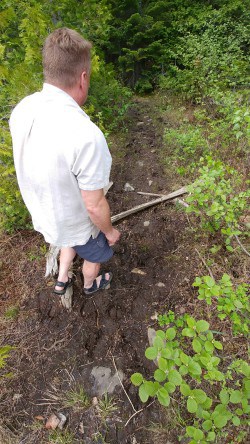 highways except for one short stint on I-95. The reasoning for this worked out to our advantage: in an actual SHTF bug-out, the highways would theoretically be jammed with people trying to evacuate high-population areas. We kicked our bug-out trip off on Friday afternoon in Maine – on Memorial Day Weekend. Here in ol’ Vacationland, Memorial Day Weekend is always a death knell for people who usually take the highways during their work commutes; the highways clog up, back up and slow down tremendously, and accidents are far more frequent. The Memorial Day traffic provided a nice touch of realism to our route, and ensured we took the roads less traveled.
highways except for one short stint on I-95. The reasoning for this worked out to our advantage: in an actual SHTF bug-out, the highways would theoretically be jammed with people trying to evacuate high-population areas. We kicked our bug-out trip off on Friday afternoon in Maine – on Memorial Day Weekend. Here in ol’ Vacationland, Memorial Day Weekend is always a death knell for people who usually take the highways during their work commutes; the highways clog up, back up and slow down tremendously, and accidents are far more frequent. The Memorial Day traffic provided a nice touch of realism to our route, and ensured we took the roads less traveled.
As I noted in Part One, we did intend on having a day of actual get-away relaxation on our trip, so in the spirit of full disclosure, I’ll admit we did stop at a grocery store to grab some burger fixings and beers. We did recognize that in an actual SHTF event, we’d avoid major shopping locations like the plague unless we were in dire need of specific items. Better to bring prep food on our bug-out (that’s what it’s there for, for Pete’s sake!) than to rely on stopping at grocery stores to get caught in a mob. But we wanted burgers, dammit – so we got some.
Related: 2 Types of Military Sleeping Bags
In transit to the bug-out location (BOL), we got a chance to brush up on our map-reading skills, when a phone GPS brought us down a podunk back road that was definitely coursing us in the wrong direction. Looking at the compass, map, and scratching our heads, we eventually figured out that the course we were taking would bring us on the west side of the target lake, which we did not want – we knew there was a rudimentary and secluded boat launch on the east side of the island. At that point, the GPS went off and the last 35 or so miles were guided in by our DeLorme Gazetteer and a compass as the sun started to set.
Are Your Map Navigation Skills Up To Snuff?
Once our travels turned off paved public roads and traversed into groomed dirt camp roads and then to unimproved ancient logging truck trails, close attention to the map started to become increasingly pertinent. Using a Jarhead Survivor-sourced map navigation trick (marking an edge of a piece of paper with the map scale to roughly gauge distances on the map) and utilizing the truck’s trip odometer to gauge distances traveled from known points, we were able to eventually wind our way to our destination. It wasn’t easy once the sun went down and it got full-on dark. As others who have traveled in the northern Maine woods will know, not all roads are mapped and the ones that are labelled on the gazetteer aren’t always 100% correct – and physical road signs are hit or miss. We bombed through some muddy, rocky wrong roads for several miles before we finally found the destination. One lesson reinforced here: if you’re leaving your comfort travel zone, have a map, have a compass, and know how to use them! Jarhead Survivor and I are both pretty accomplished map readers/users, but we still got turned around a couple times.
Arriving at the Bug Out Location
Remember how I said Maine was a mess with tourists and travelers on holidays? Well, this Memorial Day weekend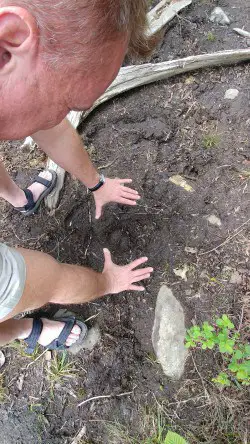 found Jarhead Survivor and I pulling up to a very secluded boat launch that really takes some effort and dedication to get to – you have to WANT to get there – just to find a truck parked, tents erected (complete with people sleeping inside) and a full campsite up and running. General lesson here, too: just because you think you’re heading to a remote location, it doesn’t mean there ain’t gonna be someone there first. Think about that when choosing a bug-out location: you’re almost definitely not the only one who has scouted or is scouting a remote site.
found Jarhead Survivor and I pulling up to a very secluded boat launch that really takes some effort and dedication to get to – you have to WANT to get there – just to find a truck parked, tents erected (complete with people sleeping inside) and a full campsite up and running. General lesson here, too: just because you think you’re heading to a remote location, it doesn’t mean there ain’t gonna be someone there first. Think about that when choosing a bug-out location: you’re almost definitely not the only one who has scouted or is scouting a remote site.
While the boat launch wasn’t where we were going to set up our permanent site, we had planned on staging there for the evening as the hour had grown late during our travels. We sat in the truck, discussed our options, and decided to head down the shoreline a bit and set up a quick camp to catch some sleep before heading to the island in the morning. In no time, we had a couple tents set up and we plunked down on a beautiful beach, cracked a beer, and listened to the loons calling before we retreated to our respective tents to snore.
We both agreed that had this been an actual bug-out, we likely would have beat feet out of there and looked for an alternate place to camp – or even launch the canoe and head for the island at night for the ultimate in low-signature escapes. (Night vision equipment suddenly looks awfully handy). However, the camp looked like it was manned by a pair of older gentlemen there to do some fishing (our analysis turned out to be true the next morning) so we didn’t feel too bad about setting up a hasty camp then bolting out at first am.
Black Flies and Mosquitoes and Gnats, Oh My!
I woke up to voices. Convivial banter with the occasional chuckle. I dragged myself out of my tent, which had been located in a depression with heights of ground around three sides. I noted Jarhead Survivor’s gear was all packed up – he had arisen before me – and he was chatting with the older gents who had the camp up shore, getting some intel on the area. The first piece of immediate intel I got from the older guys was that the bugs were going to be a problem – they were wearing long sleeves and pants, and mosquito netting headgear. Bugs weren’t bad at 5:45 in the morning, but it looked like things were going to get worse. I cursed not ever thinking of adding mosquito netting to my bug-out bag. Luckily, I had some potent bug spray squirreled away in my pack, so I took the opportunity to douse myself liberally before I got fully dressed.
Related: 4 Steps to Eating Insects
It didn’t take long. Within a half hour, an armada of flying, biting, and sucking winged critters had arisen from whatever circle of hell they had bivouacked in overnight, and attacked with fervor and apparent perverse glee. Jarhead Survivor and I raced through a quick breakfast and dragged the canoe to the water, slapping and swearing as we packed up to depart the insectoid hell.
Loading the Canoe For Salvation
As we dragged our gear through the clouds of black flies and made ready to shove off, we noticed two things: One, the wind was picking up – which is good to keep bugs away, but bad on freighted-down canoes. Two, we had too much shit. We consolidated what we could, but knew that we’d have to back off on the amount of stuff in the canoe for this trip – waves were picking up, and we would be battling our way into the wind to get to our island. Camp chairs, the Ruger 10/22 TD, a couple cooking items, some clothes, and other small items stayed behind. We cached these items in the truck for retrieval in the future if needed. In a real bug-out, we likely would have waited till close to dark and headed back to grab these items. Security and comfort would go a long way when stress levels are through the roof.
As we loaded the canoe, we took pains to keep any water-sensitive items inside a waterproof tote – canoeing can get the contents of your craft pretty wet as the guy in the stern changes sides with his paddle to steer. We also had to keep our load somewhat balanced; when you have low freeboard due to the canoe being weighed down, one good wave hitting an off-balanced canoe will ruin your day very, very quickly. In a sheer survival situation when using a boat, you have to face the possibility of one good roll resulting in the loss of 100% of your gear – so plan accordingly, pack the canoe wisely, and be smart. PFDs (Personal Flotation Devices) are absolutely essential as well. Would be a real bummer to drown while surrounded by survival gear.
Scouting the Bug Out Island From The Canoe
We decided, due to our unfamiliarity with the island, and since there was a lack of local boat traffic, to paddle around the perimeter of the island to get as much of a visual feel for the interior of the island as we could. We’d also scout for suitable landing sites. However, our initial pass revealed a complete lack of really good places to put in to the island due to heavy, thick foliage, sheer cliffs, and downed trees. From a bug-out and evasion perspective, this was perfect – others looking for a similar site would likely be dissuaded from landing. On our second go-around, we found an opening in the dense shoreline brush wide enough to poke the bow of our canoe into. We drove the canoe into the brush, and Jarhead Survivor performed an amphibious invasion of our new Bug-Out Island (BOI).
Related: 10 Bug Out Bag Essentials
I disembarked gingerly, and a few minutes of walking around revealed a plot of land sufficiently flat and brush-free to allow us to set up a rudimentary camp. The “flat” area was closer to shore than we would have liked in a bug-out – we could still see the water from where were were (and if we could see the water, in theory those on the water could see us!), but we noted that we’d need a base camp to stage ourselves before we braved the thick, nasty brush and uneven, rocky ground to find a better location.
Setting Up Our Bug-Out Camp
We paced the stone-strewn ground in our desired base camp location. There were plenty of resources – paper birch 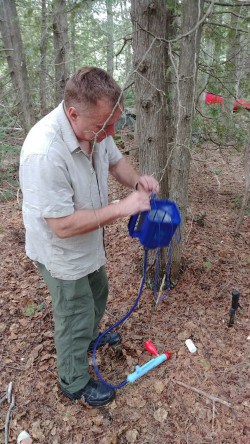 trees were available in unbelievable quantities, as were cedar trees and other softwoods, with the occasional maple sprouting up from the ground. We were surrounded by fresh water, so hydration and theoretical food (obtained via fishing) were close by. Rocky outcroppings jutted from the ground, right where they were strewn after the glacial system moved through the area millennia ago. There were no real traces of humans – no campsites, no chopped-down trees, no trails, no fire-scarred logs. Perfect.
trees were available in unbelievable quantities, as were cedar trees and other softwoods, with the occasional maple sprouting up from the ground. We were surrounded by fresh water, so hydration and theoretical food (obtained via fishing) were close by. Rocky outcroppings jutted from the ground, right where they were strewn after the glacial system moved through the area millennia ago. There were no real traces of humans – no campsites, no chopped-down trees, no trails, no fire-scarred logs. Perfect.
Related: KISS AR-15
The flat(ish) spot we chose for our tarp lean-to had a large, 4-foot-high rock pile that cut direct line of sight from the water to our south. Our view to the west and north was almost impenetrable shrubs and thick woods, to the east the water could be seen through the cedars and high-bush blueberry plants. We wanted to cut our visual signature from the water, so we placed the lean-to in front of the rocks, with the back of our lean-to facing east towards the water. With the tarp being a dull brown color, we hoped it would blend in sufficiently to keep casual passersby from noticing our camp. If necessary, there was plenty of local foliage to assist in camouflage efforts. Satisfied for the moment, we discussed what we’d do if we were to be here long-term, and agreed that this wouldn’t be a great spot for a full-on bug-out; scouting the interior of the island would be necessary later in the day to try to find a more suitable spot for future relocation needs.
However, we did concur that our current location would work for the night, and we set about making a small camp. Paracord strung between trees and poles formed our lean-to that would keep our gear dry and covered in case the darkening horizons provided rain. The paracord supports also ensured that we could cut the cordage to drop the shelter to the ground and get our gear out of sight almost immediately if needed.
A small fire pit was in order, of course. I set about the shore, trying to find football-sized rocks for the pit while 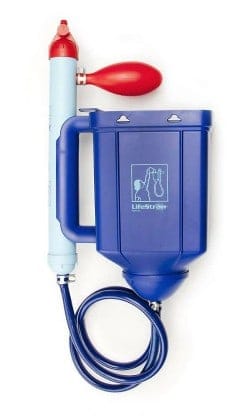 Jarhead Survivor used my pack hatchet (the E-tool Jarhead thought he’d brough was decidedly absent…oops.) to clear a depression in a mossy section of ground. 20 minutes of searching and digging yielded a perfect little pit about eight inches deep and sixteen inches across. We’d be keeping the fires small purposely. An hour or so of searching work yielded a decent pile of nice, dry cedar branches and other fuel for our fire. We’d only use the fire after dark and sparingly, so the firewood supply was definitely more than adequate…but better safe than sorry, right?
Jarhead Survivor used my pack hatchet (the E-tool Jarhead thought he’d brough was decidedly absent…oops.) to clear a depression in a mossy section of ground. 20 minutes of searching and digging yielded a perfect little pit about eight inches deep and sixteen inches across. We’d be keeping the fires small purposely. An hour or so of searching work yielded a decent pile of nice, dry cedar branches and other fuel for our fire. We’d only use the fire after dark and sparingly, so the firewood supply was definitely more than adequate…but better safe than sorry, right?
Also Read: 5 Cheap Things That Can Kill You
The rest of our gear was brought up from the canoe, and the canoe was beached well inland to keep its bright red hull out of sight. We situated our stuff and took stock of our gear. Tents would be set up later, closer to dark – but we decided on proper tent locations to keep our sleeping quarters out of sight, but comfortable. Jarhead Survivor set up his LifeStraw gravity filter off a tree limb, and we primed the filter and started filling water bottles with clean, filtered Maine lake water. Very satisfied with the filter and our general setup, we relaxed for a few to take stock, review what we’d done, and refine our plan based on our new situation and location.
Stay tuned: Part III up next.
Visit Amazon Affiliate Sponsors of Survival Cache
The post Walking the Walk Part 2: Running the Bug Out appeared first on Survival Cache.

from Survival Cache https://survivalcache.com/walking-the-walk-part-2-running-the-bug-out/
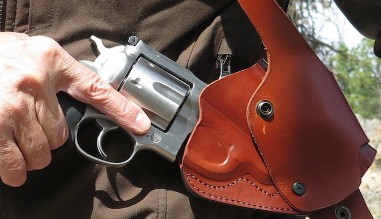
 neck-deep in metaphors, I’ll cut to the chase; a finely crafted leather shoulder holster rules the day when packing a multi-pound chunk of stainless steel bear-repelling hardware. Look, I get that city folk respect their CCW-IWB-OWB-APNDX carry holsters, but those people are moving from home to bus stop to office workstation. Me? I move from home to 4×4 to great big wide open Big Sky Montana. And my low density 41st State is jam packed with reasons to carry a hand cannon in a shoulder rig.
neck-deep in metaphors, I’ll cut to the chase; a finely crafted leather shoulder holster rules the day when packing a multi-pound chunk of stainless steel bear-repelling hardware. Look, I get that city folk respect their CCW-IWB-OWB-APNDX carry holsters, but those people are moving from home to bus stop to office workstation. Me? I move from home to 4×4 to great big wide open Big Sky Montana. And my low density 41st State is jam packed with reasons to carry a hand cannon in a shoulder rig.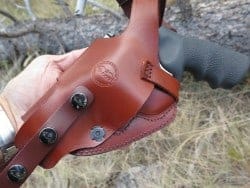 offerings. But before we go too far into the holster, let’s look at the concept. Shoulder holsters have been around forever with a Hollywood cred to back it up. From cowboy western to Dirty Harry, to Miami Vice, to Die Hard, to John Wick. If anything, the holster consuming public (which is no doubt every reader of this) may be a little gun shy when it comes to shoulder rigs due to nothing more than a lack of confidence and perhaps need. Shoulder holsters do extrude some serious gun creed that a belt-mounted holster cannot come close to unless accompanied by a flat dark earth thigh strap (if you know what I mean…and I know you do).
offerings. But before we go too far into the holster, let’s look at the concept. Shoulder holsters have been around forever with a Hollywood cred to back it up. From cowboy western to Dirty Harry, to Miami Vice, to Die Hard, to John Wick. If anything, the holster consuming public (which is no doubt every reader of this) may be a little gun shy when it comes to shoulder rigs due to nothing more than a lack of confidence and perhaps need. Shoulder holsters do extrude some serious gun creed that a belt-mounted holster cannot come close to unless accompanied by a flat dark earth thigh strap (if you know what I mean…and I know you do).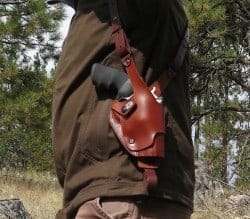 array of holsters for both city and outdoor needs, not just bothering to sell low hanging gun fruit for simple carry uses and those complex ones that need a little explaining Craft Holsters delivers the goods on advanced needs too. As one who fits into the latter category of complex needs I find the Craft Holster shoulder option an outstanding variation that fits neatly between my belt rig and my heart-covering chest rig. Dare I say the best option?
array of holsters for both city and outdoor needs, not just bothering to sell low hanging gun fruit for simple carry uses and those complex ones that need a little explaining Craft Holsters delivers the goods on advanced needs too. As one who fits into the latter category of complex needs I find the Craft Holster shoulder option an outstanding variation that fits neatly between my belt rig and my heart-covering chest rig. Dare I say the best option?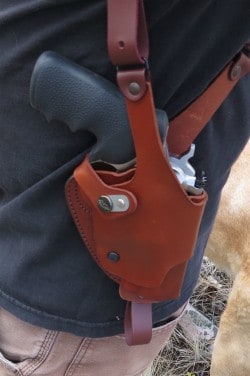
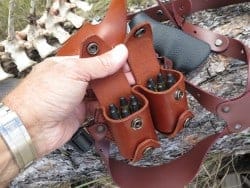 The Craft Holsters Shoulder Holster is composed of three main pieces. Obviously there is a gun container, followed by a strap system, and finally the accessories composed of two speed loader compartments. The gun holding aspect is absolutely top notch! No seriously. I’m not overusing the exclamation point. The workmanship and fit is as good as it gets, and the snugness is so right that it took a bit of work out of the box to get the Alaskan and the leather to play well together. Once fitted, there is nothing more secure than this. Now I know that reading between the lines some might worry that quality it is optional, but let me be clear that it took a moment to get the leather stretched, but after a few tries, the snap snapped and the leather locked in a perfect fit. I would not want it any other way! And you can take that exclamation point to the bank! That one too.
The Craft Holsters Shoulder Holster is composed of three main pieces. Obviously there is a gun container, followed by a strap system, and finally the accessories composed of two speed loader compartments. The gun holding aspect is absolutely top notch! No seriously. I’m not overusing the exclamation point. The workmanship and fit is as good as it gets, and the snugness is so right that it took a bit of work out of the box to get the Alaskan and the leather to play well together. Once fitted, there is nothing more secure than this. Now I know that reading between the lines some might worry that quality it is optional, but let me be clear that it took a moment to get the leather stretched, but after a few tries, the snap snapped and the leather locked in a perfect fit. I would not want it any other way! And you can take that exclamation point to the bank! That one too.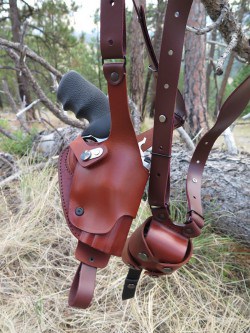 revolver upon deployment provides three levels of extraction. Once the retention strap is popped free of its snap, the Alaskan can be slid straight free. If a 45-degree rotation is needed, then so be it. The Craft Holsters Shoulder Holster accommodates a quick low-angle deployment, as well as a massive 90-degree plus rotation out of the shoulder configuration if needed. No matter the need, the Craft Holsters Shoulder Holster will deliver. So think of being rolled in an tree-lined alley by a grizzly bear. Yea. That’s what I’m talk’n bout Willis!
revolver upon deployment provides three levels of extraction. Once the retention strap is popped free of its snap, the Alaskan can be slid straight free. If a 45-degree rotation is needed, then so be it. The Craft Holsters Shoulder Holster accommodates a quick low-angle deployment, as well as a massive 90-degree plus rotation out of the shoulder configuration if needed. No matter the need, the Craft Holsters Shoulder Holster will deliver. So think of being rolled in an tree-lined alley by a grizzly bear. Yea. That’s what I’m talk’n bout Willis!

 happened with Jarhead Survivor and I on our “planned” bug-out trip, completely validating the essence of our excursion.
happened with Jarhead Survivor and I on our “planned” bug-out trip, completely validating the essence of our excursion.  highways except for one short stint on I-95. The reasoning for this worked out to our advantage: in an actual SHTF bug-out, the highways would theoretically be jammed with people trying to evacuate high-population areas. We kicked our bug-out trip off on Friday afternoon in Maine – on Memorial Day Weekend. Here in ol’ Vacationland, Memorial Day Weekend is always a death knell for people who usually take the highways during their work commutes; the highways clog up, back up and slow down tremendously, and accidents are far more frequent. The Memorial Day traffic provided a nice touch of realism to our route, and ensured we took the roads less traveled.
highways except for one short stint on I-95. The reasoning for this worked out to our advantage: in an actual SHTF bug-out, the highways would theoretically be jammed with people trying to evacuate high-population areas. We kicked our bug-out trip off on Friday afternoon in Maine – on Memorial Day Weekend. Here in ol’ Vacationland, Memorial Day Weekend is always a death knell for people who usually take the highways during their work commutes; the highways clog up, back up and slow down tremendously, and accidents are far more frequent. The Memorial Day traffic provided a nice touch of realism to our route, and ensured we took the roads less traveled. trees were available in unbelievable quantities, as were cedar trees and other softwoods, with the occasional maple sprouting up from the ground. We were surrounded by fresh water, so hydration and theoretical food (obtained via fishing) were close by. Rocky outcroppings jutted from the ground, right where they were strewn after the glacial system moved through the area millennia ago. There were no real traces of humans – no campsites, no chopped-down trees, no trails, no fire-scarred logs. Perfect.
trees were available in unbelievable quantities, as were cedar trees and other softwoods, with the occasional maple sprouting up from the ground. We were surrounded by fresh water, so hydration and theoretical food (obtained via fishing) were close by. Rocky outcroppings jutted from the ground, right where they were strewn after the glacial system moved through the area millennia ago. There were no real traces of humans – no campsites, no chopped-down trees, no trails, no fire-scarred logs. Perfect.
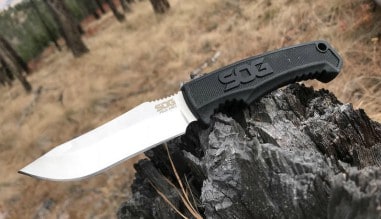
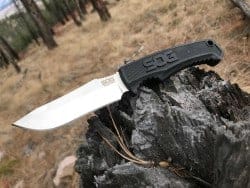
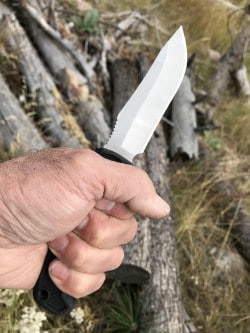
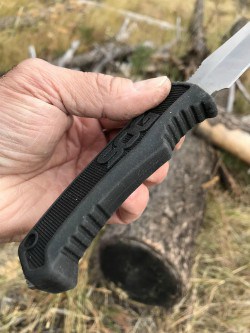 decade. But that’s not the point of this knife. The grippy handle has an index finger notch and a contained finger area ending just before the tang meaning the blade metal extends all the way through the handle and out the other side. A reasonable guard is molded into the grip and serves its purpose well. The protruding metal is solidly jimpped and can be counted on to transfer 100% pounding force to the very tip of the blade on the southernmost blade end.
decade. But that’s not the point of this knife. The grippy handle has an index finger notch and a contained finger area ending just before the tang meaning the blade metal extends all the way through the handle and out the other side. A reasonable guard is molded into the grip and serves its purpose well. The protruding metal is solidly jimpped and can be counted on to transfer 100% pounding force to the very tip of the blade on the southernmost blade end.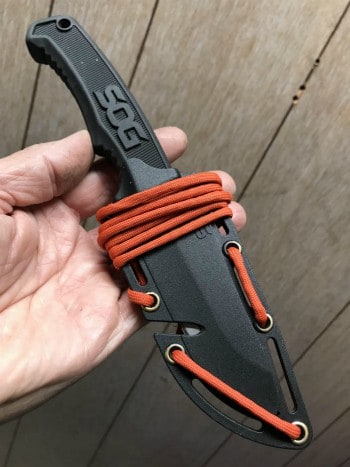
 and a highly respectable size for this price point. The blade steel is fairly unexciting at a
and a highly respectable size for this price point. The blade steel is fairly unexciting at a 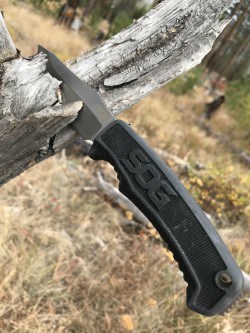 For general survival and bushcraft tasks, the
For general survival and bushcraft tasks, the